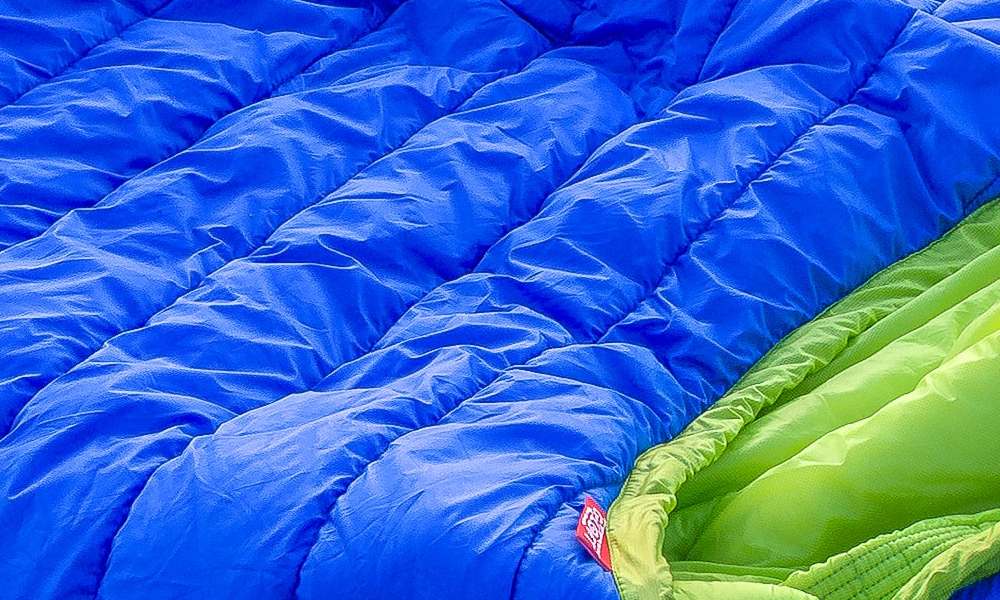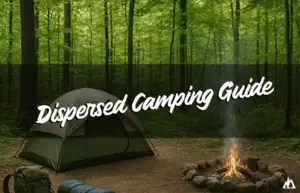Sleeping Bag Material – Fabrics and Warmth Rating Guide
Not all sleeping bags are created equal.
Depending on where you camp and the season determines the type of sleeping bag to buy.
We’ll break down the different types of sleeping bag material, fill, temperature warmth ratings, etc.
Follow this guide and research the best type of sleeping bag for your needs before buying.
Let’s dive in.
Sleeping Bag Fabrics for Shells
What type of sleeping bag material works best for shells? The inner and outer fabrics will help protect the insulation of the sleeping bag. They’re the only parts of the bag that come into contact with your body.

Nylon and Polyester
You’ll need to consider comfort, breathability, and weight when choosing the best fabric. You’ll typically find polyester, nylon, and taffeta for shell fabrics.
Nylon, polyester, and taffeta are affordable and breathable. They work well in dry conditions where you don’t have to withstand the rain.
Ripstop Advantage
If you’re looking for a serious sleeping bag material, you will need to spend a little bit more on a ripstop fabric. Ripstop fabric is a type of sleeping bag fabric that’s reinforced. The heavier material maintains spreadability but is much more durable.
Ripstop fabric materials can be polyester or nylon. The reinforced ripstop materials work well for sleeping bags that get a lot of action.
Are you planning on taking your sleeping bag on a trip where it might rain? Then you should look for a water-resistant material that’s also breathable.
Durable Water Repellant Finish
Look for moisture-wicking materials that have a durable water-repellent finish. A durable water-repellent finish will help minimize the moisture your bag absorbs. This can be especially vital for sleeping bags that are difficult to dry.
For many camping trips, ripstop and nylon materials work just fine as shell materials. If you’re going on a more intense outdoor adventure, invest in premium fabrics.
Comfortable Sleeping Bag Lining Choices
Now that you know some of the best sleeping bag choices for shells let’s dive into the lining materials. A suitable fabric for a sleeping bag lining should be smooth and breathable.
The material needs to be smooth enough that it won’t catch on your clothes. You also want to ensure the fabric has enough breathability to let the heat escape. If too much heat is trapped inside your sleeping bag, it can be challenging to catch a whole night’s rest.
Again, nylon, polyester, and taffeta work great for sleeping bag shells and linings. You’ll find that nylon and polyester come in low-end and high-end versions.
Taffeta will be the most premium material, giving you the best results. You can also look into getting poly-cotton or silk for your sleeping bag lining.
Poly-Cotton Possibilities
Have you ever felt poly-cotton before? Poly cotton is smooth and sleek. The comfortable material feels great against your skin and works best in cool climates.
Since Poly-cotton does take a while to dry, it’s not the best material for a camping trip with rain. You’ll find that most outdoor enthusiasts use poly-cotton sleeping bags during the summertime or for indoor use. Pair a poly-cotton bag with a cushy camping mattress, and you’ll sleep like a baby.
Silk Lining
Were you looking to indulge in an expensive sleeping bag? Then consider getting a luxurious silk lining. Sleeping bags with silk linings are breathable, soft, and fun.
The only downside is that silk is more delicate. You must be extra careful to keep your silk lining safe from tears. Silks will be the highest-performing materials when it comes to comfortability.
Sleeping Bag Material Warmth Ratings
Knowing what material to get is the first step in choosing a sleeping bag. Next, you’ll need to look at each bag’s warmth or temperature rating.
The rating systems help enthusiasts like yourself pick the best bag. If it wasn’t for sleeping bag warmth ratings, it’d be hard to pick a bag that isn’t too cold or warm. How exactly do sleeping bag temperature ratings work?
A warmth rating is a number that manufacturers put on their sleeping bags. The number helps you have a good idea of what sleeping bag works for what conditions.
For instance, let’s say that you need a summer sleeping bag. A summer sleeping bag will work best in moderate climates like the ones you might find in the Great Smoky Mountains National Park. In this situation, you’d want a sleeping bag with a 40° F or 4° Celsius rating.
A rating of 40° F is typically considered to be a summer sleeping bag temperature. Alternatively, a -20° F bag would be a winter sleeping bag temperature.
Winter sleeping bags work best for the coldest months of the year and extreme places like the Rocky Mountain National Park. There’s a lot of different gear, technology, and science that goes into determining sleeping bag warmth ratings.
En/ISO Rating Standards
It used to be that there wasn’t a universally agreed-upon way to rate sleeping bags. You can imagine the issues that came about as a result.
Manufacturers could put whatever rating they felt was appropriate on the bag. This lets a lot of confusion and frustration among campers worldwide. Someone would buy a winter-rated bag, only to find themselves freezing by midnight rolled around.
Campers needed a reliable way to buy sleeping bags. That’s why the International Organization for Standardization was introduced. The standard is referred to as EN-ISO 13537.
Paving away for a systematic rating system, the standard helped customers dramatically. By creating an independent testing system, campers could finally get the gear they needed. The original rating system has evolved over the years.
Now the standard is referred to as ISO-23537. Manufacturers can enjoy a more refined testing process using the same rating and testing principles.
Temperature Rating Test Complexities
Exactly how does the test work? The sleeping bag temperature rating test is quite complex. Testing companies use a heated mannequin to represent a human being.
The mannequin lays inside the sleeping bag and on a foam sleeping pad. The entire setup is placed inside a purpose-built, temperature-controlled chamber. During the testing process, evaluators take note of the mannequin’s condition.
Different sensors across the mannequin’s body help evaluators notice other benchmarks. For instance, how long does it take for the mannequin to accumulate a reasonable amount of heat in the sleeping bag?
At what temperature does heat start to escape from the bag? Is the bag good at maintaining steady temperatures? At what point does the sleeping bag lose its effectiveness?
These are all of the questions that evaluators aim to answer during the testing process. The data is loaded into computer models.
The computer models can use the information to determine additional equations. The result is more information about the effectiveness of the sleeping bag.
Professionals can interpret the numbers and data to create easy-to-understand sleeping bag ratings. The rating will be clearly posted when you purchase a sleeping bag, so you know what you’re getting.
What Rating Numbers Mean
Now that you understand how the warmth rating system works let’s take a closer look. What exactly do all of the numbers mean? You’ll find more than one number for each sleeping bag temperature rating.
Typically, sleeping bags will be marketed with a specific temperature. However, the marketed temperature is just for advertising purposes.
In other words, it’s only a part of the story. The complete sleeping bag rating will provide you with the temperature rating, comfort rating, transition, and risk data.
Definitely something to pay attention to if you’re looking to stay warm inside your tent without using any electricity.
Comfort Rating Ranges
The comfort rating or range lets you know the ideal temperature for women. Specifically, the comfort range describes the perfect temperature for a sleeping woman. Considering everyone has different body types, the rating isn’t universally accurate.
Your personal experience with a sleeping bag can vary quite a bit. The best way to choose a bag is by using the comfort rating as a guideline.
The temperature on the comfort rating isn’t a hard number. Instead, it’s a suggestion. As long as you don’t use the sleeping bag in weather conditions that are 5 to 10 degrees Fahrenheit outside of the comfort rating, you should be good to go.
Typically, it’s a wise idea to get a sleeping bag slightly warmer than the chilliest conditions you’ll face. That way, you’ll stay warm all night long without overheating.
Are you expecting to take a trip to Death Valley National Park? Death Valley Park has nighttime temperature lows of 40°F. You’ll want a sleeping bag with a design for colder temperatures.
For this extreme cold situation, you’d want to comfort rating of 30° Fahrenheit. Even if it drops 10° lower than the bag’s comfort rating, you’ll still be nice and cozy.
When shopping for a women-specific sleeping bag, remember that the comfort rating is listed as the overall temperature rating. If you only see one temperature on a woman’s sleeping bag, it’s probably the comfort rating. The following number you’ll see is the transition or lower limit range rating.
Transition or Lower Limit Range Rating
Another part of the sleeping bag rating equation is the transition number. The transition or lower limit range rating concerns comfort for a sleeping man.
The lower limit range defines when a standard man would be in a state of thermal equilibrium. What exactly does that mean? It’s the temperature where an ordinary man wouldn’t feel hot or cold.
Again, everyone’s body is different, so the rating isn’t a precise number. Instead, you’ll need to use the sleeping bags transition rating as a guideline.
Unisex and men’s sleeping bags are usually marketed using the transition number. Instead of seeing the transition rating as gender-specific, you can consider it body-specific.
Body Specific Ratings
Did you know people sleep best in temperatures between 60-65 degrees Fahrenheit? When picking your sleeping bag, the transition and lower limit range rating will help you improve comfortability.
Taller and heavier folks usually sleep warmer than petite individuals. Suppose you notice that you wake up in the middle of the night sweating, even in a chilly environment. In that case, you should probably shop for a unisex sleeping bag.
You could also focus on shopping for a men’s sleeping bag. Pay attention to the bag’s transition or lower limit range rating. Next, take note of the risk and extreme range rating.
Risk and Extreme Range Rating
Are you taking a trip where it gets freezing cold at night? Then pay close attention to the extreme range or risk range rating on your sleeping bag. If you use a sleeping bag when the temperatures are within the risk range, you’ll be in danger.
The risk range lets you know that using your sleeping bag could risk getting hypothermia. You’ll want to avoid using your bag in these extreme weather conditions, except for emergencies.
Does your bag not have a risk or extreme range rating? You can calculate it yourself!
Subtract 30° F from the comfort rating. This must apply to a comfort rating for a unisex or men’s sleeping bag.
You’ll need to subtract 45° F from the warmth rating if it’s a woman’s model. After removing your initial number, the remainder is the risk range. Be an innovative, safe camper, and avoid trips that will have temperatures in the risk range.
Choosing the Best Fabric for Insulation
There’s a considerable debate among campers worldwide. When it comes to insulating sleeping bags, should you use synthetic or down filling? The age-old question is one of the most significant choices backpackers face.
Sleeping bag insulation can make or break your camping experience. It’ll be almost impossible to get a good night’s sleep if your insulation isn’t keeping you warm or comfortable.
There really isn’t a one size fits all solution to this debate. Choosing between a synthetic and down sleeping bag means carefully weighing each material’s pros and cons.
Highlights of Down Insulation
One of the best things about down insulation is that it’s great for backpacking. You’ll find that down sleeping bags easily compress into a tiny caring sack.
The lightweight material has an excellent warmth-to-weight ratio. You don’t need a lot of down to fill your sleeping bag, and its fine structure makes it great for insulation.
When properly cared for, a down sleeping bag can last year after year. Some people even have down sleeping bags for decades!
One of the downsides to insulating with down is that it’s an expensive material. You’ll also find that once you’re down sleeping bag gets wet, it can’t provide warmth.
How will you set up your campsite? If you frequently camp in wet areas or prefer tarp camping, down insulation might not be the best choice. However, if you’re camping in cold, dry climates, it’s worth your money to invest in a down sleeping bag.
Highlights of Synthetic Insulation
Are you planning on camping in wet climates? Then synthetic sleeping bags are the way to go.
If your synthetic sleeping bag gets wet, it’ll dry much faster than a down sleeping bag can. Even when it’s still damp, a synthetic bag can provide warmth.
You’ll also find that synthetic sleeping bags are incredibly affordable. The less expensive material option can work great in a variety of climates.
Since synthetic bags don’t compress like down materials, they will be harder to transport. The construction of the fibers makes synthetic sleeping bags heavier and less durable.
You’ll find these bags aren’t the ones to pack into a sack for a long backpacking trip. Since synthetic fibers break down quickly, they will not last for decades. You can expect your synthetic bag to last anywhere from 3-7 years.
What Is Fill Power?
As you shop for a new sleeping bag, you’re bound to come across the term “fill power.” What exactly does this mean?
Fill power is a particular measurement that’s performed in a lab. It involves taking an ounce down and compressing it for a minute.
Evaluators can then measure the volume of the compressed down. The volume of the down and cubic inches determines the fill power.
The lowest fill power you’ll find in gear is 300 cubic inches. The highest fill power is 900 cubic inches. In other words, fill power lets you know the downs fluffy capabilities.
How fast can the down fluff back up after it’s compressed? The more the down can fluff, the better your sleeping bag experience.
When down has a high fill power rating, it can trap more heat for your body. Remember that the fill power rating doesn’t necessarily indicate how warm your sleeping bag will be. The warmth will depend on the amount of down inside the sleeping bag.
Pay attention to the fill grams to ensure an excellent weight-to-power ratio. For instance, let’s say you find a 400-fill jacket with 300 g of down.
In this situation, you’ll be able to stay as warm as if you were wearing an 800-fill jacket that only had 150 g of down. You’ll just be using a coat that’s a bit bulkier.
When buying jackets, the amount of down isn’t disclosed. But sleeping bag manufacturers always list the amount of down and fill power in weight.
How to Choose a Liner for Warm Sleeping Bags
So far, we’ve been discussing sleeping bag material choices that come with the bag. But what about accessories?
Sleeping bag liners are a beloved addition by campers across the globe. These handy items come in two distinct shapes; rectangular and mummy-shaped liners.
Liners are the perfect sleeping bag feature when you want to stay comfortable all night long. It’s a thin fabric bag that goes inside your sleeping bag. Your skin will be in contact with the liner.
Backpackers will enjoy using a mommy-shaped bag liner. Travelers will do best using a rectangular bag liner.
A rectangular bag liner can serve a dual purpose, helping insulate your sleeping bag and providing protection during hotel visits.
Liners also help keep your sleeping bag free of dirt and body oils. You’ll find it’s a lot easier to maintain your sleeping bag when you’re vigilant about using a liner.
There are a lot of different materials you can choose for your sleeping bag liner. One of our favorite materials has to be silk.
Silk vs. Cotton Liners
Silk is a lightweight material, and it’s excellent for insulating and cold climates. The breathable fabric works great for warm weather and is incredibly absorbent.
You’ll find that silk sleeping bag liners are on the higher end of the price scale. Consider getting a cotton material for a more economically priced sleeping bag liner.
Cotton is absorbent and strong. Even though cotton isn’t the most lightweight material, its durability makes up for it. If you’re comfortable using a bulky fabric, then fleece and microfleece liners are also great options.
Fleece vs. Synthetic Liners
Fleece and microfleece sleeping bag liners are fast drying and moisture-wicking. The heavyweight materials tend to be bulky and soft. When using a fleece liner, you can expect to add up to 12 degrees Fahrenheit to your comfort rating.
Synthetic Liners
Are you comfortable using synthetic materials? Then consider getting a moisture-wicking fabric that’s designed for humid conditions. Synthetic materials offer the perfect amount of stretch and are affordable too.
Finally, you can always look into getting an insulated sleeping bag liner. A high-quality insulated sleeping bag liner can add up to 25° of warmth at night.
You’ll be able to extend the temperature rating of your lightweight bag by quite a bit. Insulating materials can dry faster than cotton because of a hollow-core fiber design.
Pick a Sleeping Bag That Lasts
Now you know how to pick a sleeping bag material that can withstand the test of time. As long as you invest in a bag that uses high-quality fabrics and down insulation, you’ll be on the right track.
Rep The Wild loves helping outdoor enthusiasts reconnect with nature. We hope to help prepare you for your next adventure by providing the best outdoor gear reviews and insights.
Did you find the perfect sleeping bag? Make sure you take good care of it. Read all about how to wash your sleeping bag the right way and how to stay safe while tent camping.






